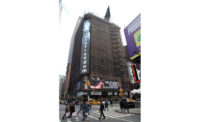Editorial Commentary
What's Missing in New York City's Safety Law

New York City’s new construction safety-training law, which will require from 40 to 55 hours of instruction for workers on many building projects, is a noteworthy effort to prevent more deadly construction accidents.
Photo: AP
New York City’s new construction safety-training law, which will require from 40 to 55 hours of instruction for workers on many building projects, is a noteworthy effort to prevent more deadly construction accidents. The city’s Dept. of Buildings says 12 construction workers have died in each of the past two years. The City Council had debated and changed the law all during the year. In recent weeks, two more workers fell to their deaths from Manhattan high-rise projects, adding urgency to the effort. The council finally adopted the law unanimously late last month (ENR 10/9 p. 44).
But worker training is only one color in the construction-safety rainbow. The employee-focused methods used by companies with the best injury records are no secret and have been spelled out over the years by groups such as the Construction Industry Institute. They include a firm commitment to safety management by top-line leaders, detailed safety planning at the crew level, empowerment of staff to stop unsafe work, involvement of craftworkers in peer safety observations, having one safety staff member per 50 to 100 craftworkers, regular drug testing, and the use and measuring of active, leading-edge safety indicators. Only a handful of companies working in New York City are known to practice safety so ambitiously. Unfortunately, in the law, the council has failed to induce all firms to take this more comprehensive approach.
The City Council failed to induce contractors in the new law to take a more comprehensive safety approach.
Other aspects of the law are regrettable. It authorizes New York City’s mayor and council president to appoint a 14-member commission to judge the viability of different training programs to be used. This large number may have more to do with politics than safety knowledge. There are plenty of good training options available, and it shouldn’t take a roomful of people to pick them.
One of the most troubling aspects in the debate over the law were positions taken by the Real Estate Board of New York, an association of developers. Instead of proclaiming its unqualified commitment to safety and safe contractors—and a willingness to pay for the safety, knowing the investment is paid back in many forms—REBNY seemed to devote itself to concern about the cost impact on the city’s growing nonunion sector. The board’s proposed safety plan focused on requiring better use of guardrails and netting to address fatal falls, which kill the most workers. But we have a suggestion for REBNY: Stop thinking about safety as something you get by adding some nets and rails. Safe construction is heavily linked to quality work, and it draws on the same processes that cut down on rework and delays. In the end, all construction participants will save time and money.
New York is a great city, but it is never finished. The innovation we will see in how structures are designed and built also must extend to ensuring as close to zero loss of life as possible. Otherwise, all who live and work in New York City will bear the costs. Training is important, but it is just one piece of what’s needed.




